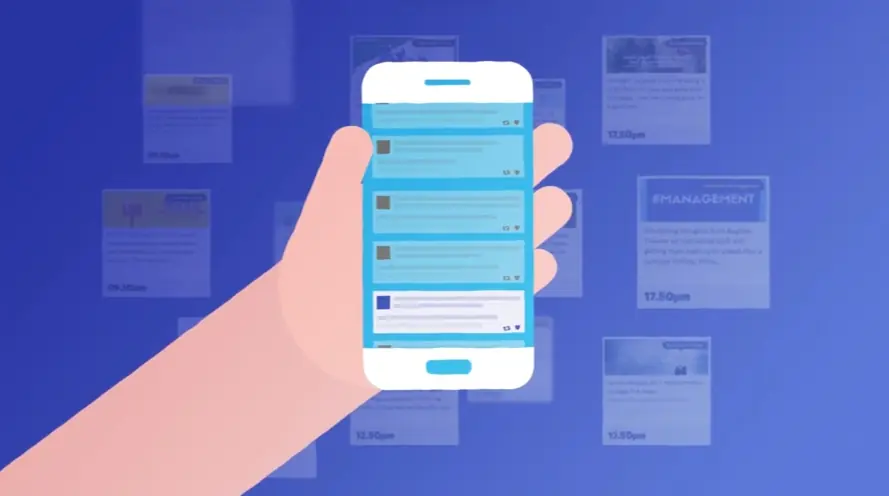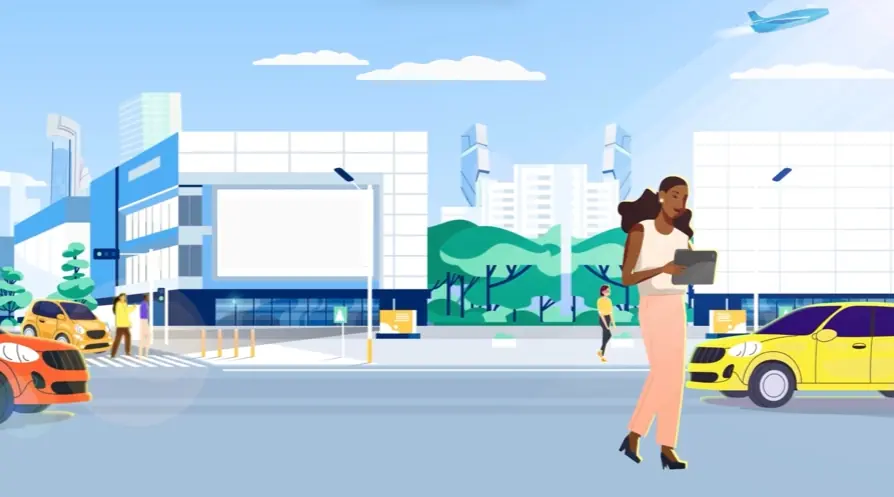We see, we feel, we connect, we thrive We understand that app advertising video creates a powerful impact, building connections with people through compelling stories. We use rich visual content as a marketing tool, fostering vibrant brand communities. As we all know, a journey of a thousand miles begins with a single step, and the growth from strategic video marketing implementations reveals truly exceptional things in today's world.
This powerful medium is not just a trend, it's the core of modern marketing. Let's explore the art of visual storytelling and dive into 30 captivating app advertising video examples that will inspire you to create impactful content.
It’s crucial to plan ahead when it comes to high-quality video production. Discuss with our team, how you can get visual style, budget, timeline in sync.
Jai Ghosh
Video Producer at Advids
Let's talk

How can we pinpoint the most compelling message for our app's target audience in a video?
Pinpoint the most compelling message by deeply understanding the app's core value and aligning it with the target audience's needs.
What specific storytelling techniques best showcase our app's value in a promotional video?
Use storytelling techniques that focus on problem-solution narratives, user journeys, and emotional connections to showcase the app's value effectively.
How do successful app companies use motion graphics in their video ads?
Motion graphics can create visually engaging ads that highlight key features, simplify complex processes, and maintain viewer interest.
What essential pre-production steps ensure a compelling app demo video?
Essential pre-production steps include detailed scriptwriting, storyboarding, and creating a clear plan for visual elements and voiceover.
How can we seamlessly integrate existing brand assets into a persuasive app video narrative?
Seamlessly integrate brand assets by maintaining consistent color palettes, typography, and logo placement throughout the video narrative.
What script structure will most effectively highlight our app's key features in a short video?
A script structure that highlights key features in a short video includes an engaging hook, a clear problem statement, a solution demonstration, and a strong call to action.
What are the most common pitfalls to avoid when creating app promotional videos?
Common pitfalls to avoid include unclear messaging, poor visual quality, lack of a call to action, and not understanding the target audience.
How can strategic voiceover enhance the emotional impact of our app's video presentation?
Strategic voiceover enhances emotional impact by using tone, pacing, and emphasis to create a connection with the viewer and reinforce the message.
What are the best practices for effectively showcasing our app's user interface in a video?
Best practices for showcasing the app's UI include using screen recordings, animations, and clear callouts to guide the viewer through the interface.
What is the ideal length for an app showcase video to maintain viewer engagement?
The ideal length for an app showcase video is typically between 30 to 90 seconds to maintain viewer engagement and deliver the key message effectively.
How can we create a visual flow that guides the viewer through the key features of our app in a video?
Create a visual flow by using smooth transitions, clear visual cues, and a logical sequence of scenes that guide the viewer through the app's features.
What are the most engaging ways to present user testimonials in an app promotional video?
Engaging ways to present user testimonials include featuring real users, showcasing their positive experiences, and using authentic quotes to build trust.
How can we use music and sound effects to create the right mood and tone for our app video?
Use music and sound effects to create the right mood and tone by carefully selecting tracks that complement the visuals and enhance the emotional impact.
How can we strategically plan our app video to maximize its impact within our marketing funnel?
Strategically plan the app video to maximize its impact by aligning it with specific stages of the marketing funnel, targeting the right audience, and using clear calls to action.
How can we use this type of video content to generate leads for our app business?
Use this type of video content to generate leads by including clear calls to action, such as downloading the app, visiting a website, or signing up for a free trial.
Who is your ideal app user for video ads?
Having explored the power of video, let's now shift our focus to the heart of effective app advertising campaigns, understanding who exactly we're trying to reach. It's not just about casting a wide net; it's about connecting with the right people.
- We need to consider users whose specific interests align with our app's core functionality. This ensures our message resonates with their needs.
- Demographics like age, location, and income provide a foundational understanding, helping us tailor our message to specific groups.
- The tech-savviness of potential users influences how they interact with video ads, so we must adapt our approach accordingly.
- Understanding user needs and the pain points our app solves is key to crafting compelling narratives.
To understand what works, let's look at some app campaign examples and see how they target specific users. We must also consider user motivations for using apps within our category, as this helps us understand their goals. We need to analyze their preferred content consumption habits, their social media engagement patterns, and their purchase history. This gives us a complete picture of their online behavior.
By taking a user-centric approach, we can create more effective video app campaign examples and build lasting connections with our audience.
What's the single biggest benefit your app offers?
Okay, we've explored understanding our users, now let's get to the heart of your app. What's that one, undeniable benefit it offers? It's not just about features, it's about the core value. Think of it as the single reason someone would choose your app over all others. This is what makes your app indispensable.
What problem does your app solve? Does it make life easier, or perhaps more fun? Does it save precious time, or offer a unique solution? These are the questions we need to ask. When creating your app advertising video, always start with this core benefit.
- Does your app simplify a complex task, making it feel effortless?
- Does it connect people in a meaningful way, fostering community?
- Is it incredibly cost-effective, offering value beyond its price?
- Does it empower users, giving them new skills or abilities?
Looking at successful app campaign examples, you'll notice they all highlight a single, powerful benefit. The most effective app campaign videos are those that clearly communicate this core benefit. While app feature videos are important, they should always support the core benefit. Focusing on this will make your app campaign videos truly resonate.
By pinpointing this core benefit, we create app campaign examples that are not only compelling but also highly effective.
How does a user typically interact with your app?
Now that we've explored who our users are, let's dive into how they actually experience your app. It's not just about their demographics, it's about their journey within your digital space. This understanding is key to creating app marketing videos that truly connect.
Think about it, what's the first thing a user sees? It's that initial app launch experience, a crucial moment for first impressions. Then, how do they move around? Their navigation patterns reveal the paths they take, the areas they explore. What features do they gravitate towards? Feature usage frequency highlights what truly resonates with them.
- Time spent per session tells us how long they engage, a key indicator of value.
- Interaction with notifications shows how responsive they are to your prompts.
- Search behavior within the app reveals what they're actively looking for.
- Content consumption habits show us what kind of content they enjoy most.
By understanding these interactions, we can create app advertisement samples that are not only visually appealing but also highly effective. We can also craft app explainer videos that showcase the app's value by understanding user journeys. All of this data helps us create more impactful app advertising video. Ultimately, this deep dive into user behavior helps us build app campaigns that are not just seen, but truly felt.
What action do you want viewers to take after watching?
Now that we've explored understanding our users, let's talk about what we want them to do after watching our app advertising videos. It's not enough to just show off our app; we need to guide viewers towards specific actions that benefit both them and us. Think of it as the next step in their journey with our app. When creating *app showcase videos*, think about the one action you want viewers to take.
- Download the app directly, this is the most immediate way to get users engaged.
- Sign up for a free trial, letting them experience the app's value firsthand.
- Create an account, unlocking personalized features and building a long-term relationship.
- Share the app on social media, helping us reach a wider audience.
We also want to encourage actions like in-app purchases, website visits, and content engagement. Our *application showcase videos* should highlight how the app solves a specific problem, guiding users to the next step. In *software advertising videos*, it's crucial to have a clear call to action. Looking at *2D app video examples*, we see how clear visuals can guide users to take action. Ultimately, we want our viewers to become active users, and these actions are the key to making that happen.
Which platform is best for your app advertising video?
Now that we've deeply explored our users, let's talk about where our app video advertisements will truly shine. Choosing the right platform isn't just about ticking boxes; it's about finding the perfect stage for our message. We need to think strategically about where our mobile app promotion videos will resonate most.
Think about it, where do our ideal users spend their time online? Are they scrolling through social media, browsing specific websites, or actively engaging with other apps? This is where we need to focus our efforts. It's not just about casting a wide net; it's about targeting the right audience with the right message.
- We need to look at platform reach, making sure our message gets seen by a large enough audience.
- Granular targeting options are key, so we can reach specific user segments with precision.
- Let's explore In-app video advertising opportunities to reach users where they are most engaged.
- If we are using 3D app video examples, we need to make sure the platform supports them.
Ultimately, the platform we choose will significantly impact our campaign's success. By carefully considering these factors, we can ensure our app video advertisements are not only seen but also acted upon. This is where our efforts will pay off, leading to increased downloads and user engagement.
What is the best narrative structure for your app video?
Now that we've explored understanding our users, let's talk about the stories we tell in our app video commercials. A compelling narrative isn't just about showing off features; it's about creating a connection, making viewers feel something. Think of your video as a mini-movie, a journey that takes them from a problem to a solution, with your app as the hero.
We should always start with a problem, something our audience can relate to. Then, we introduce our app as the answer, showing how it makes life easier or more fun. Remember, the most effective short app videos are those that feel like a natural progression, not a sales pitch. Let's show the app in action, highlighting key features that directly address the problem.
- Get straight to the point, keeping their attention with a clear message.
- Use visuals to tell the story, show don't just tell, let the visuals speak.
- Evoke emotion, make them feel something, not just see something.
- Always include a clear call to action, guiding viewers to the next step.
Looking at successful app video samples, we see how they often use a relatable story to connect with viewers. Sometimes, animated app video examples can really capture the imagination, allowing us to tell stories in a unique way. Ultimately, the best narrative is one that resonates with our audience, making them want to learn more about our app.
How to create an emotional connection with your app video?
We've explored understanding our users, now let's talk about making them *feel* something through our app video marketing examples. It's not enough to just show what our app does; we need to create a connection that resonates on an emotional level. Think of it like this, how can we move beyond simple demonstrations and create narratives that truly touch our audience?
- Start with relatable scenarios, mirroring everyday situations users face, making the app feel relevant to their lives.
- Highlight the pain points our users experience, showing how our app offers a solution to their frustrations.
- Showcase genuine emotions, not just superficial reactions, creating a sense of authenticity and trust.
- Craft authentic stories that feel believable, developing characters that viewers can empathize with, just like some of the best app video animation examples.
When creating app promo video examples, remember that visuals are key. Use them to evoke feelings, not just display features. Choose music that enhances the emotional tone, and control the pacing to build emotional impact. Let's emphasize human connection, showing how our app fosters a sense of community.
Ultimately, effective app advertising video examples use emotion to build a connection with their audience, leading to better engagement and a lasting impression.
How does your app solve a user's specific problem?
We've talked about knowing our users, now let's see how app videos become problem solvers. Think of those compelling *app explainer video examples* you've seen; they don't just show features, they demonstrate solutions. They show how an app simplifies complex tasks, saving us precious time.
These videos often show how an app connects people, fostering community, or offers a unique solution unavailable elsewhere. They empower users, giving them new skills, or simply make life more fun. When you browse *app store video examples*, you'll notice how the best ones focus on solving a specific problem.
- A great app video focuses on a single problem, showcasing features that directly address it.
- They emphasize ease of use, illustrating the app's impact on daily life.
- Relatable scenarios help viewers see themselves using the app.
- Visuals show the app in action, making it tangible.
Looking at *app video case studies*, we see how focusing on a single problem can significantly boost user engagement. Many *app video portfolio examples* showcase how the app empowers users, giving them new skills or abilities. Ultimately, app videos are powerful tools for demonstrating how an app solves real user problems, making our lives easier and more enjoyable.
What is the most effective script structure for your video?
We've explored understanding our users, now let's talk about crafting a video narrative that truly connects. Think of those captivating *app launch video examples*, they all follow a clear structure. It's not just about listing features, it's about guiding viewers through a story.
- Start with a hook, something that grabs their attention immediately, like a question or a surprising fact.
- Make the challenge relatable, show you understand their pain points, what frustrates them.
- Present your app as the hero, the solution they've been searching for, highlighting its main value.
- Show, don't just tell, demonstrate key features in action, using engaging imagery.
When we look at successful *app video advertisement examples*, we see a common thread, a well-defined narrative. The best *app video design examples* show us how visuals can tell a story, enhancing the narrative. Even the most impressive *app video production examples* start with a solid narrative, it's the foundation. Keep it concise, respect their time, and use simple language. Evoke a feeling, make them feel something, not just see something.
A well-structured narrative is the backbone of any successful app video. Remember, it's about telling a story that resonates with your audience, making them want to learn more.
What is the primary conversion goal of your app video?
Okay, we've explored understanding our users, now let's get real about what we want them to DO after watching our App Video. It's not enough to just show off our app; we need to guide them towards a specific action, a clear next step. Think of it as the single most important thing we want them to do, the primary conversion goal of our video.
What is that one action? Is it a quick download, a free trial sign-up, or creating an account? This is where our Advertising Campaign focus comes in. It's about choosing that one key action that will drive results. Our App Advertising efforts hinge on this clarity.
- Do we want them to download the app right away, experiencing its value immediately?
- Should we encourage a free trial, letting them explore the app's features firsthand?
- Is creating an account the best way to build a long-term relationship with our users?
- Or is social sharing the primary goal, helping us reach a wider audience?
Ultimately, defining this primary conversion goal is crucial. It ensures our App Video is not just visually appealing, but also highly effective, guiding viewers towards the desired action. This focus is what makes our Advertising Campaign Video truly impactful.
Author & Editor Bio
A video producer with a passion for creating compelling video narratives, Jai Ghosh brings a wealth of experience to his role. His background in Digital Journalism and over 11 years of freelance media consulting inform his approach to video production. For the past 7 years, he has been a vital part of the Advids team, honing his expertise in video content planning, creation, and strategy.
His collaborative approach ensures that he works closely with clients, from startups to enterprises, to understand their communication goals and deliver impactful video solutions. He thrives on transforming ideas into engaging videos, whether it's a product demo, an educational explainer, or a brand story.
An avid reader of modern marketing literature, he keeps his knowledge current. Among his favorite reads from 2024 are "Balls Out Marketing" by Peter Roesler, "Give to Grow" by Mo Bunnell and "For the Culture" by Marcus Collins. His results-driven approach ensures that video content resonates with audiences and helps businesses flourish.





